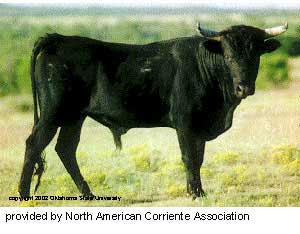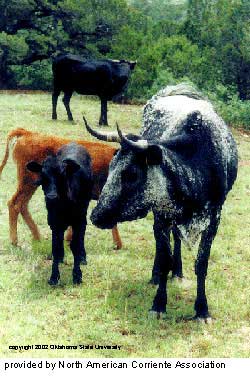Corriente Cattle
 The Corriente can be traced back to the first cattle brought to the new world by the
Spanish as early as 1493. These cattle were hardy breeds chosen especially to withstand
the ocean crossing and adapt to their new land. They were brought to the West Indies
and south Florida, as well as to Central and South America. Over the centuries the
descendants of these cattle bred for different purposes - milk, meat and draft animals.
They also adapted through natural selection to the various regions in which they lived.
Eventually, their descendants spread across the southern U.S. and up the coast of
California.
The Corriente can be traced back to the first cattle brought to the new world by the
Spanish as early as 1493. These cattle were hardy breeds chosen especially to withstand
the ocean crossing and adapt to their new land. They were brought to the West Indies
and south Florida, as well as to Central and South America. Over the centuries the
descendants of these cattle bred for different purposes - milk, meat and draft animals.
They also adapted through natural selection to the various regions in which they lived.
Eventually, their descendants spread across the southern U.S. and up the coast of
California.
In the early 1800's, European and other breeds were introduced to the new world, and by the 1900's many ranchers in the Americas were upgrading their herds with modern beef cattle. Nearly pure descendants of the original Spanish cattle almost disappeared, but some managed to survive with little human care or intervention in remote areas of Central and South America, and in very limited numbers in some areas of the southern U.S.
Today there is evidence of a worldwide growing interest in preserving various strains of these hardy, native cattle. Cattle associations in Spain, South America and Florida are making efforts similar to the N.A.C.A.'s to recognize their attributes, though few actually support registries.
 The Name "Corriente": In Central and South America, the various descendants of the
early Spanish cattle are generally referred to as "Criollo." In parts of northern
Mexico, they are often called "Corriente," although this term is frequently used for
any small cattle of indiscriminate breeding and not just for the type of cattle recognized
by the N.A.C.A. "Corriente" became the most common term used at the border to refer
to the cattle purchased for rodeo use. Consequently, most North American cattlemen,
ropers and doggers know this name, and it was chosen by the founders of the N.A.C.A.
to be used for this registry.
The Name "Corriente": In Central and South America, the various descendants of the
early Spanish cattle are generally referred to as "Criollo." In parts of northern
Mexico, they are often called "Corriente," although this term is frequently used for
any small cattle of indiscriminate breeding and not just for the type of cattle recognized
by the N.A.C.A. "Corriente" became the most common term used at the border to refer
to the cattle purchased for rodeo use. Consequently, most North American cattlemen,
ropers and doggers know this name, and it was chosen by the founders of the N.A.C.A.
to be used for this registry.
John E. Rouse, in his book, World Cattle, Vol. III, Cattle of North America, explains the names used in Mexico.
"Descendants of the original Spanish cattle, little influenced by modern breeds, are now seen only in the remote parts of the country. These are generally known as Criollo cattle, although in the state of Sonora the term Corriente is more common, and in Baja California the word Chinampo is used. All these terms, meaning "common cattle" or "cattle of the country" are applied to more or less pure descendants of the Spanish cattle, as well as to the indiscriminate mixtures of these and more recently introduced breeds.
In Florida, the few remaining small, native cattle - cousins of the Mexican Corriente are called Scrub cattle or Cracker cattle, and similar cattle in Louisiana are called Swamp cattle.
Regardless of the name, the N.A.C.A. has made great inroads toward defining, describing and preserving these cattle as a specific breed.
